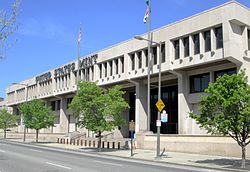The US has a long, well for us, history of minting coins. In 1792 we established the US mint. The official place to make coinage! Now to be clear, people were making items that were traded for commodities (Wampum anyone) since we got here and stared needing stuff. Then the European settlers used all kinds of foreign currency before the US was the US.
So now coins are manufactured at mints. In the US we have 4 mints in operation right now, West Point, Philadelphia, Denver and San Francisco. Other places have been used in the past (Charlotte, Dahlonega, New Orleans, Carson City).
Philly Mint
A mintmark of one or two letters indicates exactly where a coin was made, because we like to keep track of these things! Mintmarks can be placed on the front or back of a coin, it is like a game of Where’s Waldo sometimes
Fun Fact: Most people just refer to the “heads” or “tails” part. Coin collectors or dealers call them the obverse or reverse, because we know they like to be different!
A mintmark of one or two letters indicates exactly where a coin was made, because we like to keep track of these things! Mintmarks can be placed on the front or back of a coin, it is like a game of Where’s Waldo sometimes
Fun Fact: Most people just refer to the “heads” or “tails” part. Coin collectors or dealers call them the obverse or reverse, because we know they like to be different!
See the red circle = mintmark
How many coins were produced at an individual mint (where coins are made) in a given year can be a guide to rarity and value. If the reported mintage is extremely small, it makes sense the current dollar value could be very large.
A number of high quality, brand new low mintage coins have sold for more than $1,000.000. Sometimes, many coins from a specific year and mint were never placed in circulation for everyday commerce and were simply melted down. So even a reported “high” mintage coin from a particular year can be very rare due to specific circumstances.


